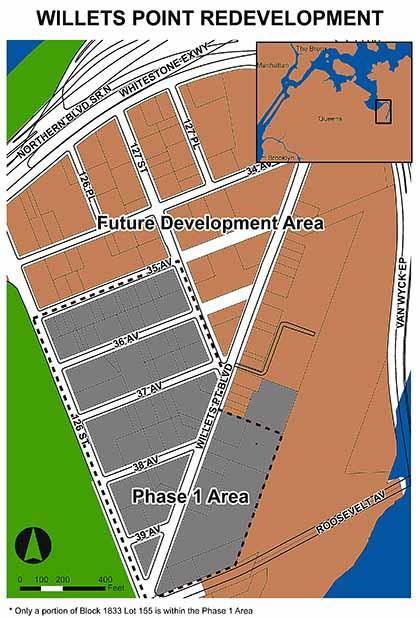By Connor Adams Sheets
The city took a giant leap toward realizing its vision of redeveloping the neglected Willets Point area last week, announcing that nine business owners who have yet to accept relocation agreements will be receiving notices this week that the city is beginning the legal process to seize their properties via eminent domain.
The businesses are the last of the holdouts in Phase 1 of the plan for the 62-acre area. The city already has purchase agreements with the other 88 percent of the businesses in the parcel of 20 acres bounded roughly by 126th and 127th streets and 35th and Roosevelt avenues.
The controversial move, which sets the city on a track that could end with its seizing land in the Iron Triangle, comes at a time when the Economic Development Corp. has yet to hire a developer or draw up plans of what exactly it intends to do with the land.
“As we seek to reach agreements with the nine remaining businesses, we will also begin the legal process that gives us the option to condemn these properties if needed, so that we can continue to move forward,” Julie Wood, a spokeswoman for the city EDC, said via e-mail. “In 2011, progress will include issuing [a request for proposals] for a developer in April and starting infrastructure work.”
In 2007, the city confirmed that developers are interested in the project by sending out a request for qualification, to which 29 firms responded. The current plan for Phase 1 is for up to 1.3 million square feet of development, including affordable housing, retail, a hotel, 2 acres of open space and various associated infrastructure improvements. The entire project is proposed to include more than 5,000 apartments, 1.7 million square feet of retail and a hotel to be built in three phases.
But Willets Point United, a group of Willets Point business owners and others joined in opposition to the redevelopment plan, said in a statement that the move to file eminent domain papers was hasty.
In its statement, the group reiterated its long-held view that their businesses should not be condemned or land taken in order to make room for private development. It also said the city needs to finalize plans for ramps to handle the added traffic the project is expected to bring to the Van Wyck Expressway.
“Eminent domain was never intended to facilitate decisions by members of an elite class, to repurpose property according to their own preferences, to be used by their fellow elites — and in the process trample the rights of private property owners, like us,” the group said. “As events unfold, we urge observers to always be mindful of the very serious property rights issues that are implicated, which may eventually impact others as they are now impacting us.”
If the nine remaining Phase 1 business owners refuse to leave their property, the situation will go before the courts, which have not been consistent in their rulings on eminent domain, though the landmark 2005 U.S. Supreme Court case Kelo v. City of New London set the precedent that governments could seize land on behalf of a private developer for uses deemed to be in the public good, which in that case included economic development.
Despite the concerns many have about the proposal, Wood said that when it is finished, the project will be a boon, bringing economic development and much-needed jobs to Queens.
“When this project is complete, it will create a brand new neighborhood with thousands of jobs, affordable housing options and a vibrant retail sector and it will remediate decades of environmental damage,” Wood said.
Reach reporter Connor Adams Sheets by e-mail at csheets@cnglocal.com or by phone at 718-260-4538.


































